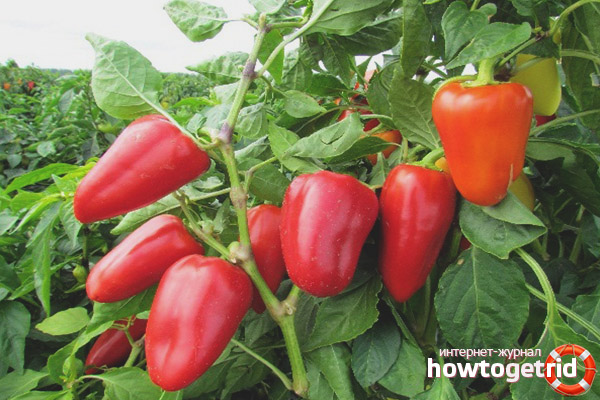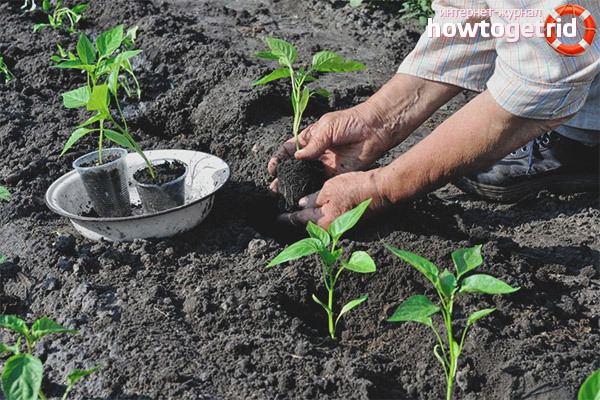The content of the article
Variety of bell pepper Flight is characterized by high productivity and excellent taste. The plant is resistant to most nightshade diseases. The bush is medium-sized, up to 75 cm, fruits. The fruits of the pyramidal shape, uniform, at the stage of biological maturity acquire a bright red color, the skin is smooth, glossy. The presentation of the fruit is excellent. In regions with a cold climate, it is recommended to grow in glazed greenhouses.
Pepper Polet is very popular, both among professionals and among beginner gardeners. Fruits can be frozen, stuffed, pepper is good for cooking lecho and other preparations for the winter. With proper care and good weather conditions, the harvest will delight you until late autumn. The optimal time for planting is the last decade of May, the plant will not tolerate unexpected frosts.
How to grow seedlings in a city apartment
First of all, you need to take care of acquiring a soil mixture for growing seedlings. This culture does not tolerate acidic soils; pepper prefers neutral soils with a pH value of -7. You can prepare the soil for seedlings yourself. To do this, you need to take black soil, rotted leaves, peat, river sand, some wood ash.
- Buy pepper seeds only at specialized seed stores, from trusted suppliers. Remember that bell pepper seeds are stored for no more than 2 years.
- Before sowing, treat the planting material with a growth stimulator, for example, heteroauxin, you can immerse the seeds for 10 minutes in a solution of potassium permanganate. Most gardeners grow seedlings in boxes, pots, and old dishes.
- It is recommended to check the seeds for germination, for this they will be placed in a container of water, the floating seeds will be discarded.
- Prepared seeds are sown in containers at a distance of 1-2 cm from each other. Do not bury the seeds, just sprinkle them on top with a thin layer of fertile soil.
- After sowing, spray the soil from the spray bottle with warm water and cover it with glass or film. For the first stages of germination, sunlight is not required, enough moisture and heat, but as soon as the first loops of shoots appear, the containers should be transferred to the windowsill, closer to the light.
- Some novice gardeners try to sow seeds as early as possible, in early March, and even in February, in the hope of getting an early harvest. This is not the right approach. The fact is that at the end of winter - the beginning of spring, the daylight is still short, the plants will not have enough sunlight. Seedlings will stretch, become unviable, frail, prone to disease. Such plants, as a rule, do not tolerate transplanting well, take root for a long time, get sick and give a very meager crop. As practice shows, it is impossible to cure such seedlings neither by top dressing, nor by timely irrigation, nor by other agrotechnical measures. Start is very important in plant life.
- If you still decide to sow the seeds in early March, take care of additional lighting. And remember that pepper does not tolerate drafts and even a short-term decrease in temperature to 8 degrees. At a temperature of 22-24 degrees, the seeds will germinate in 6-7 days.
- The first top dressing is performed 2 weeks after emergence. Attention! At a temperature of 10 degrees, pepper stops growing, leaves fade, roots stop growing, the plant freezes.
- In the stage of three true leaves, the plants are dived with obligatory transplantation into separate pots. If you leave the plants in one container, then they will begin to compete with each other for solar energy, nutrition and water.Picking is an important procedure that stimulates the growth of the root system.
- Do not water too often young seedlings, do not forget that the tanks should have a drainage and a hole to drain excess moisture.
Good seedlings succeed in five-liter containers from under drinking water. Remember that with waterlogging, bell pepper can get sick, the root system will lag behind in growth. With regular waterlogging, the roots rot, the plant withers and dies.
Planting seedlings in the ground or greenhouse
Young plants should be planted in open ground in the last days of May. Take your time to do this earlier, as return frosts can ruin unheated seedlings. Sweet pepper loves warmth and light. Moreover, the larger the fruits, the more heat-loving the plant.
- Do not plant overgrown seedlings, it restores roots for a long time, often lagging behind in growth.
- Add humus to the grooves or holes, pour plenty of water. Take plants out of containers with extreme care. Pepper roots are easily injured, and in general, bell pepper does not tolerate transplantation, much worse than, for example, tomatoes.
- Immediately after planting, once again pour bushes under the root with necessarily warm water.
- It is recommended to shade plants from scorching sunlight and sudden gusts of wind. To do this, use agrofibre or other non-woven covering materials.
Do not rush with top dressing, the first fertilizer application can be carried out 2 weeks after transplanting seedlings into the ground. For this, ammonium nitrate, urea and complex fertilizers are used.
Outdoor cultivation
Immediately after planting, the soil under the bushes should be mulched with straw or mowed grass. Mulch prevents the evaporation of moisture from the surface layers of the soil. Under the mulch layer, worms and insects actively develop, which structure the soil and saturate it with air.
- Seedlings need to be spud. Do not forget to timely remove weeds and loosen the ground.
- Pepper Polet is very responsive to the application of organic fertilizers. The use of herbal infusion as fertilizer showed very good results. When fertilizing with various fertilizers, it is necessary to ensure that the soil does not dry out.
- For active growth, one large watering is enough every 5-7 days.
- Herbal infusion can be prepared independently in the garden or summer cottage. Mowed grass, weeds are laid in a metal barrel, poured with warm water and left to ferment for a couple of weeks. After the fermentation process is completed, the liquid is filtered, diluted with water and the seedlings are watered under the root.
- Weeding is an important procedure. Weeds take nutrients from the soil. To prevent fusarium, in rainy weather, preventive spraying of bushes with copper-containing preparations is necessary.
- Pepper Flight feels more comfortable in closed ground conditions, respectively, and the crop can give more. Plants that are too close to each other suffer from a lack of light.
The plant can be grown both in greenhouse conditions and in open ground. Fruiting pepper. The flight continues until the frost.
Video: Pepper Flying











Submit